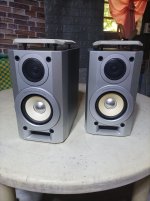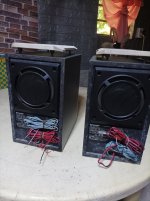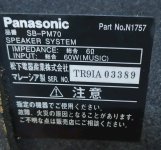Hi,
I bought these pair of Japan made surplus speakers. I intend to use it for my DIY amp. However I didn't realize that it comes with 2 pairs of wires. Is there a way to convert them for single wire use? something like parallel or maybe series parallel combination.
Thanks!
I bought these pair of Japan made surplus speakers. I intend to use it for my DIY amp. However I didn't realize that it comes with 2 pairs of wires. Is there a way to convert them for single wire use? something like parallel or maybe series parallel combination.
Thanks!
Attachments
I'm guessing one runs to the rear woofer. Could you try to confirm that either by looking into it or using a meter. If that's not possible you might use a small battery.
When you have different woofers in parallel, they may partially cancel each other at frequencies where they differ.
The first things I'd probably do is determine the resistance of each to see whether you can safely run them in parallel. Check the front one measures resistance to see there's no high pass filter on it. Listen with and without the rear woofer playing and decide whether it has a similar sensitivity to the front one, meaning you'll hear a clear increase in bass, but not a very large increase.
This way you could consider using both at once, or even using one to make a 2.5 way.
If you can measure them, even better.
The first things I'd probably do is determine the resistance of each to see whether you can safely run them in parallel. Check the front one measures resistance to see there's no high pass filter on it. Listen with and without the rear woofer playing and decide whether it has a similar sensitivity to the front one, meaning you'll hear a clear increase in bass, but not a very large increase.
This way you could consider using both at once, or even using one to make a 2.5 way.
If you can measure them, even better.
My guess is that Panasonic actually used an active system for these and that the electronics unit, that came with the system, utilised 4 power amplifiers. Two channels for the woofer/tweeters on the front and then two channels for the 'sub' woofers on the back.
Quite how they would perform with the woofers wired in parallel is another question entirely.
Quite how they would perform with the woofers wired in parallel is another question entirely.
If the amplifiers can handle half the impedance, I guess there will be little change other than having two radiators.
Nico, that was my worry 6ohms in parallel will become 3ohms, I'm thinking of re wiring the tweeter and the front woofer in series and then connect them in parallel with the rear woofer. I do not know if this is possible though. I may have to take a peek inside I guess and see how the speakers are wired.
Last edited:
By the way the last image was a photo I've taken from the internet in order to show a clear model number (the same as mine).
If the amplifiers can handle half the impedance, I guess there will be little change other than having two radiators.
You are ignoring the fact that you are bypassing the active crossover and also ditching the level adjustability of the sub. Instead you will get a bloated, booming upper bass and midrange.
I know you have very good expertise on amps but speakers are a bit more than just impedance.
Why bypass the active cross-over, that seems a bit silly. You should have asked. Really not just about impedance? Well please give us a full lecture on impedance and AC circuits, I would appreciate this a lot. Are you talking acoustic impedance, electrical impedance or will you combine the two so we can learn about the overall effect. Thanks. I know nothing, here is your chance to teach an ignorant person something. I will ask some questions though and trust that you know your subject well enough to answer these. Begin with -j. 🤓 Knowing most amplifiers are constant voltage source, please explain two same impedances in parallel, do they spilt the current between them or double the current. Under what condition would impendence become negative if at all? How does frequency affect impedance, what about pressure, or ports, or ......
Last edited:
Why bypass the active cross-over, that seems a bit silly.
Because that's what you suggested.
You should have asked. Really not just about impedance? Well please give us a full lecture on impedance and AC circuits, I would appreciate this a lot.
You might want to start with Ohms law first.
Pleas enlighten me where I suggest to bypass the electronic cross over. Don't make inaccurate statements.
Do you know Ohm, where was he from, I think I met him but that was only in passing, we did not discuss much. But I asked you to explain complex impedance and explain where -j comes from. I think you need to brush up on you ac theory a little. Do you know what I am referring to?
It think we are talking about different people, I do not know Ohn, what did he do that was important?
By the way I don't believe in Free Lessons, they are usually Bullsh!t Anything free is not worth learning about. Tell me is root of two real or imaginary. After that we can move to -J
Last edited:
Nico that's what you suggested above when you said...
In other words connecting the secondary woofer up to the same amplifier terminals as the primary one. This would therefore bypass the secondary woofer, specific, active crossover and also place any active crossover, meant for the primary woofer/tweeter, onto the secondary woofer too . Your above statement indicating that you thought there would be little change Vs having the speakers driven with two separate amplifiers.
This would not be the case, as was pointed out, by ICG, when this was said...
You then replied with this...
The quote at the top of this post is advocating for doing just that as I explained.
If the amplifiers can handle half the impedance, I guess there will be little change other than having two radiators.
In other words connecting the secondary woofer up to the same amplifier terminals as the primary one. This would therefore bypass the secondary woofer, specific, active crossover and also place any active crossover, meant for the primary woofer/tweeter, onto the secondary woofer too . Your above statement indicating that you thought there would be little change Vs having the speakers driven with two separate amplifiers.
This would not be the case, as was pointed out, by ICG, when this was said...
You are ignoring the fact that you are bypassing the active crossover and also ditching the level adjustability of the sub. Instead you will get a bloated, booming upper bass and midrange.
I know you have very good expertise on amps but speakers are a bit more than just impedance.
You then replied with this...
Pleas enlighten me where I suggest to bypass the electronic cross over. Don't make inaccurate statements.
The quote at the top of this post is advocating for doing just that as I explained.

Okay, personalities aside for a moment as I don't like conflict on a sunny Sunday afternoon and am apt to pull the trigger rather quickly.
Thank you for your understanding and cooperation.
- Home
- Loudspeakers
- Multi-Way
- Micro-component speakers


